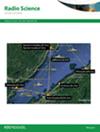采用两种测量方法对某航天级低温低噪声放大器的噪声温度进行了分析
IF 1.5
4区 地球科学
Q3 ASTRONOMY & ASTROPHYSICS
引用次数: 0
摘要
低温低噪声放大器(cro - lna)的噪声直接影响太赫兹超导外差接收机的灵敏度。本文旨在评估低温lna的噪声温度及其作为外差接收机,特别是中国空间站巡天望远镜高灵敏度太赫兹探测模块一级中频放大器的适用性。采用冷衰减器(CA)法和变温负载(VTL)法来确保测量值的置信度。在0.1-2 GHz频率范围内,结果的最大差异为1K,导致接收机噪声温度的不确定性达到4K。详细分析了噪声温度的测量精度,重点分析了低温衰减器的影响和温度梯度下连接电缆的噪声贡献。此外,还验证了cryo-LNA的噪声温度与物理温度和辐射硬度的相关性,以评估其在空间应用中的适用性。本文章由计算机程序翻译,如有差异,请以英文原文为准。
The noise temperature analysis on a space-grade cryogenic low noise amplifier using two measurement methods
The noise of a cryogenic low-noise amplifier (cryo-LNA) directly impacts the sensitivity of a terahertz superconducting heterodyne receiver. This paper aims to evaluate the noise temperature of a cryo-LNA and its suitability as the first stage IF amplifier for the heterodyne receiver, specifically the high-sensitivity terahertz detection module for the China Space Station Survey Telescope. Both the Cold Attenuator (CA) Method and the Variable Temperature Load (VTL) Method are employed to ensure confidence in the measured values. The maximum difference in results is 1K within the frequency range of 0.1–2 GHz, contributing to an uncertainty of 4K in the receiver's noise temperature. The measurement accuracy of the noise temperature is analyzed in detail, with particular emphasis on the influence of the cryogenic attenuator and the noise contribution from the connecting cable with a temperature gradient. Additionally, the dependence of the cryo-LNA's noise temperature on physical temperature and radiation hardness are verified to assess suitability for space applications.
求助全文
通过发布文献求助,成功后即可免费获取论文全文。
去求助
来源期刊

Radio Science
工程技术-地球化学与地球物理
CiteScore
3.30
自引率
12.50%
发文量
112
审稿时长
1 months
期刊介绍:
Radio Science (RDS) publishes original scientific contributions on radio-frequency electromagnetic-propagation and its applications. Contributions covering measurement, modelling, prediction and forecasting techniques pertinent to fields and waves - including antennas, signals and systems, the terrestrial and space environment and radio propagation problems in radio astronomy - are welcome. Contributions may address propagation through, interaction with, and remote sensing of structures, geophysical media, plasmas, and materials, as well as the application of radio frequency electromagnetic techniques to remote sensing of the Earth and other bodies in the solar system.
 求助内容:
求助内容: 应助结果提醒方式:
应助结果提醒方式:


